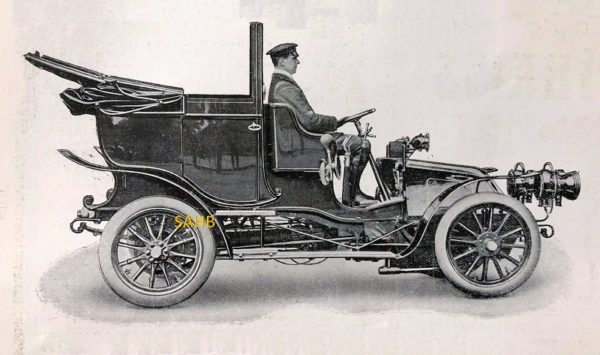
This motor car looks conventional. It is not. In 1904, so advanced in design was the Wilson-Pilcher that an article on the car in The Automotor Journal spread over three issues.
The Wilson-Pilcher company was founded in 1899 by Walter Gordon Wilson in London to produce motor cars. Wilson had been working with Percy Pilcher on an engine for an attempt at powered flight, but Pilcher died in a gliding accident in that year. According to Bonhams information at the sale of the only known survivor in 2012, a wooden mock-up of the car in existed in 1899, and a photo of a working car was taken at Stanhope Hall in 1900.
The company was acquired in 1904 by Sir W. G. Armstrong Whitworth & Co. Ltd., and production moved to Newcastle upon Tyne. Our Snapshot dates from late in 1905, when this landaulette was one of four Wilson-Pilchers due to be shown on Armstrong Whitworth’s stand at the Olympia Motor Show. Production ceased in 1907.
The car’s main technical features were: an engine with horizontally-opposed cylinders (four on the 12/16 h.p. seen in our Snapshot and six on the 18/24 h.p.) with automatic inlet valves; an epicyclic gearbox with four forward and four reverse speeds and a clutchless gearchange; and shaft drive to a helical bevel rear axle. There was more. The engine mountings allowed sideways rocking, limited by a pair of helical springs at the front and by diagonal radius rods between the rear of the gearbox and the rear axle. This largely isolated engine vibration from the chassis and occupants. An early prototype had a water-cooled head and air-cooled block, but the production cars were fully water-cooled. Both engines had identical cylinders of 3.75 inches bore and stroke, giving 2.7 litres capacity for the smaller and 4 litres for the larger engine. Each cylinder was bolted onto the aluminium crankcase, with the cylinders offset to allow each to have its own crank pin. There were crankshaft bearings between each pair of cylinders. A speed governor provided an early form of cruise control. The gearbox was bolted directly onto the engine and contained a main cone clutch and two epicyclic gears, allowing four forward speeds. All gears were helical, significantly reducing gear noise. Reverse was provided by the rear axle and operated by a reversing lever separate from the gearchange lever – so the cars had as many reverse gears as they did forward gears. Reversing was achieved by changing which of the large crown wheels engaged with the drive on the end of the propeller shaft.
Wilson later designed the Halford lorry and was involved in developing the first British tank in 1915. But his name is most remembered for his invention of the Wilson pre-selector gearbox, used by many manufacturers in the 1930s.
Picture courtesy of the Richard Roberts Archive







Just the one Wilson-Pilcher car survives, a 1904 model currently owned by the famous motor racing designer, now MD and Technical Director of Formula One, Ross Brawn